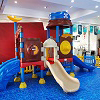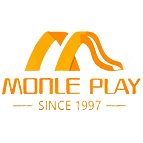What Do You Call The Main Structure Of A Playground?
The main structure of a playground is typically referred to as the ground equipment or playset. This is the central element of the playground, usually consisting of a combination of platforms, slides, climbing elements, and sometimes swings or ropes. The play structure is designed to encourage physical activity, imaginative play, and social interaction among children. It serves as the focal point of most playgrounds and is often the first thing that catches a child's attention. Play structures can vary greatly in size, shape, and complexity, from small, simple structures to large, multi-level playgrounds with a wide range of activities.

Types of Outdoor Playground Equipment
Outdoor playgrounds offer a variety of equipment that caters to different age groups, developmental needs, and physical abilities. Below are some of the most common types of playground equipment found in many playgrounds:
1. Slides
Slides are one of the most popular and recognizable pieces of playground equipment. They come in various shapes, sizes, and materials, with straight, spiral, or tunnel slides being the most common. Slides are great for developing motor skills as children climb up and then race down. There are also different variations, such as wave slides or double slides, which allow for social play.
2. Climbing Structures
Climbing equipment helps children develop strength, coordination, and problem-solving skills. These structures can include climbing walls, rope ladders, monkey bars, and rock walls. Climbing challenges vary in difficulty and can be designed to suit different age groups. For younger children, climbing may involve small steps or gentle inclines, while older children might tackle more advanced rock-climbing walls or rope nets.
3. Swings
Swings are another classic piece of playground equipment. Swings allow children to experience the sensation of flying through the air while engaging in core muscle development and coordination. They come in various types, including traditional swings, tire swings, and bucket swings for younger children. Swings encourage physical movement and can be an excellent way for children to calm down after high-energy play.
4. Seesaws (Teeter-Totters)
Seesaws are simple yet fun pieces of equipment that promote balance and teamwork. They require two children to work together to go up and down, teaching them coordination, balance, and communication. Modern seesaws may also have springs for added bounce or may be designed in a way that allows for independent use.
5. Merry-Go-Rounds
Merry-go-rounds, also known as "spinning" rides, are another fun addition to many playgrounds. These typically consist of a circular platform that children can push or spin, experiencing centrifugal force as they rotate. While they are not as common as some of the other equipment types, merry-go-rounds are still loved by children for the excitement they offer.
6. Balance Beams
Balance beams help children develop balance and coordination by requiring them to walk across a narrow surface. These beams can be set at various heights and may be straight or curving, depending on the design of the playground. Balance beams are often a part of obstacle courses and are a great way for children to engage in physical challenges.
7. Interactive and Educational Play Panels
Many modern playgrounds now feature interactive play panels that provide opportunities for learning and sensory play. These panels might include puzzles, musical instruments, or texture boards. They help children develop cognitive skills and stimulate creativity, often providing a quieter, more reflective option for play.
8. Sandbox
The sandbox is a timeless playground feature that encourages sensory exploration and imaginative play. Children can dig, build, and create, using their hands and simple tools to engage with the sand. Sandboxes promote social play and can help develop fine motor skills as children scoop, pour, and mold the sand.
9. Spring Riders
Spring riders are small, animal or vehicle-shaped play structures mounted on springs. Children sit on these riders and bounce up and down, which helps with balance and coordination. These pieces of equipment are often seen as part of smaller playgrounds, providing a fun and accessible play option for younger children.
10. Tunnels and Crawlers
Tunnels provide an exciting opportunity for children to crawl through, often as part of a larger obstacle course. Tunnels can be straight or winding, and they help children build strength and coordination. These structures often feature bright colors and are designed to engage children’s imagination, creating an element of adventure in the playground.
Conclusion
In summary, the main structure of a playground is typically called the playground equipment or playset, which serves as the central hub for children’s play activities. It incorporates a variety of equipment designed to engage children physically, socially, and cognitively. From slides and swings to climbing walls and sandboxes, the variety of outdoor playground equipment offers countless opportunities for children to explore, challenge themselves, and interact with others. Whether in a local park, schoolyard, or community center, playgrounds provide valuable spaces for children to grow, learn, and have fun.





.jpg)

